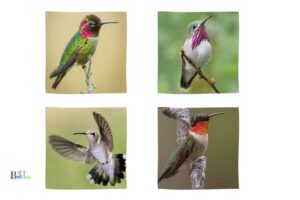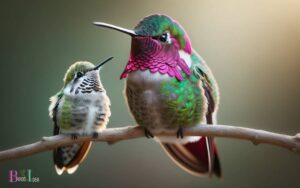Ruby Throated Hummingbird in Flight: Hovering, Speed!
The Ruby-Throated Hummingbird, with its emerald feathers and ruby-red throat, is a marvel in motion.
When in flight, it flaps its wings at a staggering rate of about 50 beats per second, allowing for impressive maneuvers such as hovering, rapid ascending, and even flying backward.
Its compact size and lightweight, averaging around 3-3.5 inches in length and a weight of 2-6 grams, contribute to its aerial agility. Darting from flower to flower, they play a crucial role in pollination, sipping nectar with their long, specialized bills.
The Ruby-Throated Hummingbird is predominantly found in North America, especially during the warmer months as it migrates to Central America during winter.
Its flight capabilities are extraordinary:
These hummingbirds exhibit sexual dimorphism, where males display a bright ruby throat, which they use in mating displays and territorial defense. Females lack this coloration but share the iridescent green back and white belly.
Capturing the exquisite details of a Ruby-Throated Hummingbird in flight is a testament to nature’s intricate design and the bird’s exceptional adaptation to aerial life.

Key Takeaway
The Science of Hovering
The science of hovering in the flight of the Ruby Throated Hummingbird is a complex yet fascinating subject that involves the intricate coordination of wing movements and aerodynamic principles.
Hummingbirds achieve their remarkable hovering ability through a unique combination of wing morphology and flight mechanics.
Their wings move in a figure-eight pattern, creating lift on both the forward and backward strokes, allowing them to remain suspended in the air.
Additionally, the rapid flapping of their wings, which can reach up to 80 beats per second, generates enough lift to counteract gravity. This extraordinary feat requires precise control of wing movement and airflow dynamics.
Understanding the science behind hummingbird hovering not only sheds light on the remarkable capabilities of these tiny birds but also provides valuable insights for the field of biomimicry and aviation technology.
Wing Morphology and Flight Adaptations
Achieving their remarkable hovering ability, Ruby Throated Hummingbirds rely on their unique wing morphology and flight adaptations, which enable them to maneuver with exceptional agility and precision in their aerial environment.
The hummingbird’s wings are long, narrow, and highly specialized, allowing them to beat at a remarkable rate of 50 to 80 times per second during normal flight and up to 200 times per second during mating displays.
This rapid wing movement creates lift on both the forward and backward strokes, enabling them to hover in mid-air and perform acrobatic aerial maneuvers.
Additionally, their ability to rotate their wings in a figure-eight pattern further enhances their agility and maneuverability. Such adaptations are essential for the hummingbird’s foraging behavior, as they enable the bird to reach nectar from flowers while hovering.
Aerial Maneuverability and Speed
Exhibiting remarkable agility, the Ruby Throated Hummingbird’s wing morphology and specialized adaptations not only contribute to its hovering ability but also enable exceptional aerial maneuverability and speed.
This tiny bird possesses astonishing capabilities that allow it to perform incredible aerial feats, including:
- Rapid Acceleration: The hummingbird can swiftly accelerate in any direction, thanks to its powerful wing muscles and unique flight mechanics.
- Precision Flying: It can navigate through intricate environments with remarkable precision, showcasing its ability to change direction rapidly while in flight.
- High Speed: Despite its small size, the hummingbird can reach impressive speeds, making it a true marvel of aerodynamic efficiency.
- Agile Maneuvers: Its capacity for sharp turns and sudden stops demonstrates unparalleled agility, making it a master of aerial acrobatics.
These remarkable abilities make the Ruby Throated Hummingbird a captivating symbol of aerial prowess in the animal kingdom.
Feeding Behavior in Midair
When it comes to feeding in midair, the ruby-throated hummingbird exhibits remarkable hovering abilities. Its precision in flight allows it to sip nectar from flowers with incredible accuracy.
This feeding behavior showcases the agility and control of the hummingbird as it navigates through the air.
Hovering and Sipping Nectar
The hummingbird’s midair feeding behavior, characterized by its hovering and nectar sipping, showcases remarkable agility and precision in flight.
This unique feeding technique allows the hummingbird to sustain its high energy levels and meet its substantial metabolic demands.
The sight of a hovering hummingbird delicately sipping nectar from a flower evokes a sense of wonder and admiration for the avian world.
Witnessing this behavior can evoke emotions such as:
- Awe: The graceful and almost magical sight of a hummingbird suspended midair while delicately sipping nectar inspires a sense of awe.
- Delight: Observing the tiny bird’s nimble movements as it flits from flower to flower brings delight and joy to the observer.
- Amazement: The precision and agility demonstrated by the hummingbird in midair elicit feelings of amazement at the wonders of nature.
- Fascination: The intricate interplay between the hummingbird and the flowers it feeds from sparks a sense of fascination with the natural world.
Precision in Flight
One can appreciate the ruby-throated hummingbird’s remarkable precision in midair feeding, showcasing its agility and mastery of flight techniques. As the bird hovers near a flower, it uses its specialized bill to extract nectar with unparalleled accuracy.
The hummingbird’s ability to maintain a stable position while rapidly flapping its wings allows it to access nectar from even the most delicate blooms.
Its precision in flight is further evident when it swiftly darts from one feeding site to another, displaying quick and calculated movements.
This exceptional control over its flight enables the hummingbird to efficiently locate and extract nectar from numerous flowers in a short span of time, highlighting its remarkable aerial capabilities.
Mating Rituals and Aerial Displays
During the mating season, Ruby Throated Hummingbirds engage in intricate aerial displays to attract potential mates. These displays are not only a means of courtship but also a testament to the agility and prowess of these remarkable birds.
The male hummingbirds perform breathtaking aerial maneuvers, showcasing their vibrant plumage and agility, while emitting high-pitched sounds to capture the attention of females.
The elaborate displays serve as a visual and auditory spectacle, captivating observers with the beauty and grace of these tiny creatures.
Witnessing these displays evokes a sense of wonder and admiration for the natural world, highlighting the extraordinary lengths to which animals go to find a mate and continue their species.
It is a reminder of the captivating and awe-inspiring aspects of nature that unfold around us.
Understanding Hovering and Energy Expenditure
When studying the flight patterns of the Ruby-throated Hummingbird, it becomes evident that their ability to hover differs significantly from their forward flight.
This hovering capability plays a crucial role in their energy-efficient foraging strategies, allowing them to access nectar from flowers with precision and minimal energy expenditure.
Understanding the biomechanics and energy dynamics of hovering versus forward flight provides valuable insights into the remarkable adaptations of these avian species.
Hovering Vs. Forward Flight
The examination of hovering versus forward flight in Ruby Throated Hummingbirds involves a detailed understanding of energy expenditure and aerodynamic mechanics.
When considering the differences between hovering and forward flight, it’s essential to comprehend the unique challenges that each type of movement presents for these tiny birds.
Here are four key points to consider:
- Hovering demands an immense amount of energy as the bird must beat its wings rapidly to remain stationary in the air.
- Forward flight requires less energy compared to hovering, as the bird can utilize aerodynamic lift to support its weight.
- Transitioning from hovering to forward flight involves a complex interplay of muscle coordination and wing adjustments.
- The ability of these birds to seamlessly switch between hovering and forward flight showcases their remarkable agility and mastery of flight dynamics.
Energy-Efficient Foraging Strategies
How do Ruby Throated Hummingbirds employ energy-efficient foraging strategies while understanding the mechanics of hovering and energy expenditure?
These remarkable birds have evolved several energy-saving adaptations that enable them to efficiently forage for nectar. When hovering, hummingbirds utilize a figure-eight pattern with their wings, generating lift on both the forward and backward strokes.
This unique flight mechanism allows them to conserve energy compared to other birds that rely on gliding. Additionally, hummingbirds have a high metabolic rate, which enables them to process energy quickly and efficiently.
They can adjust their energy expenditure by entering a state of torpor during periods of food scarcity, lowering their metabolic rate dramatically to conserve energy.
By understanding these mechanisms, researchers and enthusiasts gain insight into the remarkable energy-efficient foraging strategies of the Ruby Throated Hummingbird.
Flight Patterns and Migration
Flight patterns and migration are critical aspects of the ruby-throated hummingbird’s behavior and life cycle. These tiny birds exhibit remarkable navigation abilities and undertake incredible journeys.
Here are some fascinating facts about their flight patterns and migration:
- Non-stop flights: Ruby-throated hummingbirds embark on non-stop flights across the Gulf of Mexico, covering approximately 500 miles in one go.
- Precise navigation: Despite their small size, these birds navigate with astonishing accuracy, using celestial cues and an innate sense of direction.
- Long-distance travelers: During migration, these birds travel thousands of miles, crossing borders and ecosystems to reach their breeding and wintering grounds.
- Perseverance and endurance: The migration journey requires immense physical endurance and determination, making it a challenging yet awe-inspiring feat for these remarkable creatures.
Predation Avoidance Strategies
During their remarkable migration, ruby-throated hummingbirds employ predation avoidance strategies to ensure their safety and survival as they navigate perilous landscapes.
These tiny birds face numerous threats from predators such as larger birds, snakes, and insects.
To evade these threats, they have developed several remarkable strategies:
| Predation Avoidance Strategy | Description |
|---|---|
| High-speed evasion | Utilizing their incredible agility and speed, hummingbirds can swiftly change direction and altitude to escape predators. |
| Cryptic coloration | Their iridescent feathers and rapid movements make it challenging for predators to spot them amidst foliage and flowers. |
| Alarm calls | Hummingbirds emit high-pitched alarm calls to alert nearby birds of potential danger, allowing them to flee to safety. |
| Nesting in concealed locations | Choosing well-hidden and camouflaged nest sites reduces the likelihood of predators discovering their vulnerable offspring. |
Human Impact and Conservation Efforts
The human impact on ruby-throated hummingbirds’ habitat and conservation efforts to protect them are significant concerns for wildlife conservationists and environmental organizations.
These tiny birds face numerous challenges due to human activities, but dedicated conservation efforts offer hope for their survival.
Here are some of the key factors shaping the current reality for ruby-throated hummingbirds:
- Habitat loss and fragmentation due to urbanization and deforestation.
- Pesticide use affecting their food sources and causing direct harm to the birds.
- Climate change leading to shifts in their migratory patterns and impacting their breeding success.
- Conservation efforts including the creation of protected areas, habitat restoration, and public awareness campaigns.
These factors underscore the urgent need for continued conservation measures to ensure the thriving future of these remarkable birds.
Conclusion
The ruby throated hummingbird’s ability to hover and maneuver in flight is a remarkable feat of adaptation and evolution.
As the saying goes, “necessity is the mother of invention,” and the hummingbird’s specialized wing morphology and feeding behavior are a testament to this.
Understanding the complexities of their flight patterns and behaviors is crucial for conservation efforts and minimizing human impact on their habitats.






